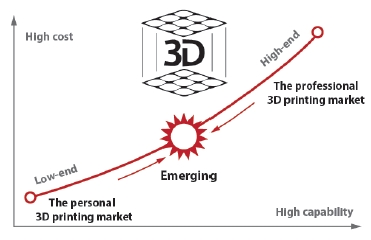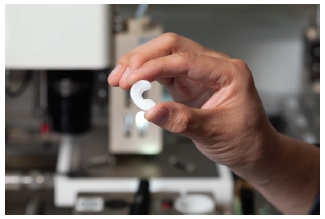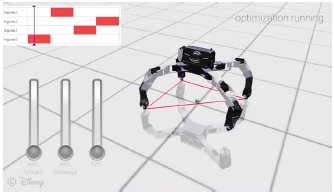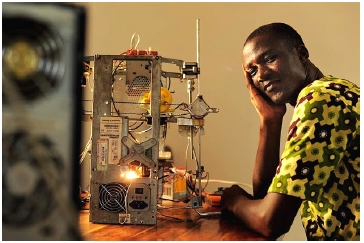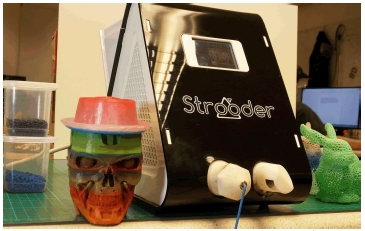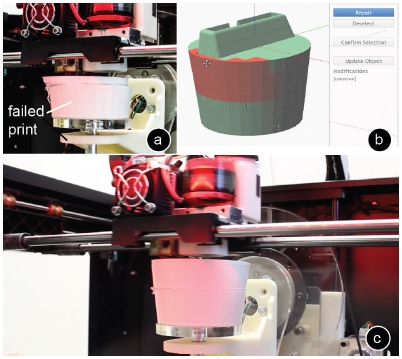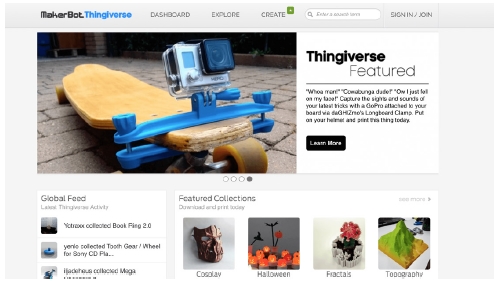
Market Analysis and the Future of Sustainable Design Using 3D Printing Technology
Background 3D printing, also known as additive manufacturing, is revolutionising prototyping and the production of end-products. This technology is concentrated in two different segments of the market: high-end industrial printing and lower-end consumer printing (PwC, 2014). In addition, according to Faludi, et al. (2015), the 3D printing industry is moving towards a future where sustainable manufacturing will be prevalent. However, very few studies have focused on market analysis and design futuring with regard to 3D printing. Moreover, most previous studies have paid little attention to research on the new applications of and sustainable development associated with this technology; therefore, more research on these issues is needed. The aim of this study is to analyze the market of 3D printing technology and to consider the future of sustainable design using 3D printing technology.
Methods This study undertook a literature and market review and examined cases involving 3D printing technology. Cases were selected from two major categories–professional printing and personal printing– and focused on case studies that exemplified sustainable 3D printing, as highlighted by the literature review. Furthermore, this study draws on the sociology of expectations in order to analyze the hopes and future visions associated with 3D printing technology. The analysis made use of a variety of published materials, such as books and theses.
Results The following results were reached. Firstly, professional 3D printing has been very successful. It has brought about significant changes to the high-end market and continues to do so. This technology also has the potential for delivering customization within the mass market. Secondly, 3D printing is moving from professional printing to personal use and becoming a very useful tool for the general public. However, an important step in this development would be the use of sustainable materials and a more efficient printing system.
Conclusions Although this technology presents challenges for a variety of reasons, it is nonetheless a creative and sustainable innovation. In addition, sustainable materials and open source software can help in the future application of sustainable design using 3D printing technology.
Thus, this study will provide information to people in disadvantaged situations previously excluded from the business world and academia, and facilitate their contributions to the development of 3D printing for design.
Keywords:
3D Printing, Technology, Market Analysis, Sustainable Design1. Introduction
3D printing is a promising technology that has unlimited potential with regards to fast prototyping. Even though 3D printing was invented almost thirty years ago in the late 1980s, it has – so far – only been used by specialists in specific industries (Fonda, 2013).
Currently 3D printing is used mainly by high-end users, and its main effect in modern times is within mass-market manufacturing. An example of the transition from professional 3D printers to more modern, low-cost models is Adrian Bowyer’s RepRap Project developed in 2004. Barnett (2016) claims that in the future, 3D printing could be advanced enough to create almost anything, such as an entire aircraft. However, despite the near-endless possibilities for its use within different industries, the use of 3D printing by the general public has been limited.
This study aims to analyze the market and provide a prediction for the future of sustainable design using 3D printing in new, emerging fields of application. Thus, this study will explore and analyze the applicability of 3D printing in the modern market by comparing the markets of 3D printing in the professional industry and for personal use. Furthermore, the applicability of 3D printing will be analyzed by exploring 3D printing with regards to the sustainability of its development. Finally, in the closing section, future possibilities and challenges for sustainable design using 3D printing will be explored and analyzed.
2. Background
In recent years, the technology of 3D printing has garnered considerable attention from around the world. The International Data Corporation (IDC) (2016) has estimated that the market value for 3D printing will increase dramatically – from $11 billion (USD) in 2015 to almost $27 billion by 2019. Other estimates, for example from the McKinsey Global Institute (Manyika, J. et al., 2013), predict that the value of the 3D printing industry could rise to between $230 billion and $550 billion by 2025 (2013).
Perhaps as a result of Adrian Bowyer’s RepRap Project, 3D printing technology has become increasingly widespread since its invention three decades ago. Bowyer, director of the RepRap Project, has even succeeded in creating a self-replicating 3D printer and has shared it as an open-source model. According to Jones, et al. (2009), Bowyer’s initiative, which was the driver behind the production of 2,500 3D printers in approximately 18 months, was also crucial in lowering prices of 3D printers between 2010 and 2012.
Nevertheless, it is important to consider both ends of the spectrum. At one end, there are machines for personal use that cost substantially less because they are commonly based on open-source software (Fonda, 2013), but these machines have limited capabilities. At the other end, there are expensive machines that use closed source software but, in turn, have greater capabilities. As shown below in Figure 1, 3D printing markets are segregated into two categories: the professional 3D printing market and the personal 3D printing market. High-end printers are typically targeted at businesses and 3D printing services, while lowend printers are targeted at consumers and enthusiasts. However, today the two ends of this spectrum are converging in the middle from a new emerging market, resulting in 3D printing machines that have high performance levels but a lower price point (Earls and Baya, 2014).
In the last few years, there has been a growing emerging market for 3D printing. This is reflected in printers from 3D Systems and Mark Forge’ which have lower price points but still provide professional features such as the ability to print using carbon fiber composites and in multiple colors.
It is also notable that 3D printers for personal use can aid sustainable development. A prime example is the 3D printer created from e-waste by Kodjo Afate Gnikou. It has been calculated that the final price for this system is around just $100. This innovative and sustainable method of recycling e-waste has created many opportunities for the use of 3D printing in West Africa. The next section will further explore both the personal and industrial 3D printing markets and analyze sustainable 3D printing markets.
3. 3D Printing Market Analysis
In this section, case studies were conducted for the analysis of the 3D printing market. These case studies are given below in Table 1.
1. According to EY (Ernst & Young)’s Global 3D Printing Survey(2016), the automobile, medical and robotic industries have substantial current applications using 3D printing, and consider its future potential as high. Therefore, in the professional 3D printer market analysis, three main professional applications were selected, based on EY’s Survey.
2. In the personal 3D printer market analysis, two cases were selected that have contributed significantly to the widespread growth of 3D printing. The first case is the RepRap project that initiated the first self-replicating machines and boosted the personal 3D printing market (Fonda, 2013). Straub & Kerlin(2014) state that 3D scanners facilitate easier 3D modelling processes and provide an accurate 3D model of a building for public use. Thus, the 3D personal scanner Fuel 3D 360° was selected as the second case study.
3. In the last section, three cases were selected which relate to the sustainable 3D printing market (3D printers, 3D printing material and 3D printed products). The first case focused on Daniel Hayduk’s recycled E-waste 3D printer, while the second case is Omni Dynamics’ Strooderfor re-making 3D printing materials. In addition, sustainable 3D printed products are illustrated by Adidas’s ‘Futurecraft 3D’ which uses recycled ocean plastic.
3. 1. The Professional 3D Printing Market
The 3D printing industry continues to grow and become more successful. This technology has been widely used in fields ranging from architecture and design to the automobile and medical industries, as well as in the development of robots and other industry sectors.
When 3D printers were first invented in 1989, they were quite limited in their applications, in addition to being expensive and substantially bigger than modern machines (Lipson & Kurman, 2013). In its former years, 3D printing technology was known as ‘rapid prototyping’ using ‘Fused Deposition Modelling’ (FDM). This innovative invention was created by S. Scott Crump, co-founder of Stratasys was successful in taking this invention and creating numerous applications for 3D printing in a range of industries. In October 2016, it was estimated that Stratasys together with 3D Systems were two of the largest corporations in the 3D printing industry, with market capitalisations of $1.66 billion and $1.11 billion, respectively (Barmatt, 2016). Despite these two major companies dominating the 3D printing market, there are a few other companies that specialise in the manufacture of 3D printers, including Organovo, Arcam, SLM Solutions and ExOne. In addition, 3D printing was – and still is –used in the manufacturing of parts in the automotive industry. For instance, the low-energy car ‘Urbee’ was the first model to have its outer shell printed in 3D (see Figure 2). Designed to beamalgamated into normal traffic, this passenger car has full external and internal 3D prints and employs digital manufacturing. This car also has lightweight components with 3D printing technology, which delivers lower weight considerations and provides better fuel economy.
Another area where 3D printing technology could be utilized is in the medical industry. In fact, 3D printed organs and tissues have been used to treat patients. Dr Mao’s team at Columbia University, together with researchers from Washington State University, designed a bone cell called ‘Kneecap’, which primarily consists of silicon, zinc and calcium phosphate, that could be printed using 3D technology. Once injected, these premature bone cells eventually mature within the body and become living bone tissue (see Figure 3). However, due to potential risks of bio-printing, for instance from side effects from harmful substances that may exist in the print, this technology is still in development.
Lastly, the robotics industry may also benefit from utilizing the technology of 3D printing to manufacture parts. For example, walking have been developed by Disney Research and Carnegie Mellon University, created using 3D printers. By using 3D printers the researchers were able to customise and control the size and shape of these robots (Disney Research, 2015) (see Figure 4). However, the prominence of 3D printing in robotics remains uncertain due to the various challenges facing this industry. In the next section, the personal use of 3D printers will be explored and compared with the industrial use of 3D.
3. 2. The Personal 3D Printing Market
As mentioned before, the RepRap Project directed by Adrian Bowyer, aimed to create a ‘maker’ culture (Fonda, 2013), and led to 3D printer software becoming open source and therefore available for anyone to use (see Figure 5). This resulted in the production of printers that were more efficient and had higher levels of performance, and subsequently lowered the cost of 3D printers.
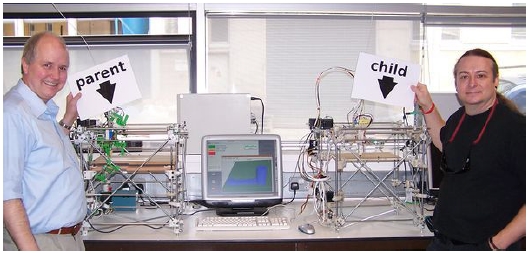
The RepRap Project’s Self-replicating Machines with Adrian Bowyer (left) and Vik Oliver (right)(Source: Jones, 2009)
Currently, there are various types of 3D printers for personal use available on the market, usually costing less than $5000 (Context, 2016). As of 2015, this personal 3D printer market was led by XYZ printing, with 17% market share, followed by 3D Systems (12%) and Stratasys (9%). The key question concerning personal 3D printers is how they have affected society. One example of their impact is how 3D printing has encouraged participatory design that is centered on the user. This type of design can be observed in numerous community workshops, including the Maker Movement and FabLabs, amongst others, where designers share 3D printing-related ideas (Barnatt, 2013). This allows many people to participate in DIY and DIWO (do-it-with-others) activities.
In addition, there are various companies that have made their interfaces relatively simple and offered free sources so that users can produce and manufacture their own designs using personal 3D printers. For instance, MakerBot provides its customers with information about the design process by releasing free design sources and hosting discussions. Moreover, 3D scanning has made it possible for users to translate an image into 3D data that can subsequently be printed. Notably, the scanner shown in Figure 6, ‘The Fuel 3D 360° Scanner’, incorporates an accurate measurement and high-speed image capturing system, which can be used to capture extremely detailed 3D data in 360 degrees. It is possible that personal 3D printers will eventually be incorporated into general households, resulting in further growth of the ‘maker’ movement. The following section will explore and analyze the implications of 3D printing with regard to sustainable development.
3. 3. The Sustainable 3D Printing Market
Industrial 3D printing seems to have made huge strides towards adoption by mainstream society, and yet there remain many potential drawbacks to this technology. To offset these disadvantages, 3D printing needs to focus on sustainable development. Firstly, 3D printing can be considered more sustainable if it uses environmentally-friendly materials and adopts more efficient use of resources. For instance, biodegradable materials such as polylactic acid (PLA) are potential eco-friendly substitutes for petroleum-based plastics. This is because PLA is a water-soluble filament derived from natural resources such as corn starch and sugarcane, making it renewable. It can be used as a supporting material beneath other materials, as well as being reused. In addition, soy plastics, recycled coffee-based plastics, and recycled PET (Polyethylene terephthalate) plastics can be great resources for sustainable 3D printing.
Secondly, recycling and repairing parts is an important part of 3D printing. As mentioned earlier, Togo-based inventor Gnikou made a 3D printer from discarded electronic equipment such as broken computers, printers and scanners. He created a functional printer, which he named W. Afate, is currently selling for around$100 (see Figure 7). His philosophy behind this invention was to give Africans the opportunity to use advanced technology whilst also demonstrating the potential of e-waste recycling.
Thirdly, if the majority of people have their own 3D printers in the future, personal fabrications will become more commonplace. However, the widespread adoption of 3D printers would also increase the problem of waste from 3D printing. This means that reused and plastic waste must become the standard filament of 3D printing. Otherwise, plastic waste from 3D printing may exacerbate our existing waste problem. Some companies are working towards a solution to this problem, as highlighted by Omni Dynamics’ Strooder (Omni Dynamics, 2016) (see Figure 8). This machine re-melts plastic pellets or recycled plastic into 3D printing filaments. In addition, Refil company was launched in the light of a growing plastic waste problem and provides re-filaments made from recycled PET bottles and car dashboards (Refil, 2015).
Finally, as a sustainable 3D printing case study, Adidas has developed it first model ‘Futurecraft 3D’, a pair of shoes which uses a 3D printer for recycled plastics recovered from the ocean. It launched these concept shoes under the banner ‘3D-printed ocean plastic’ at the 2015 United Nation’s Climate Change Conference held in France on December 11th (see Figure 9). As part of the fashion design manufacturer’s ongoing commitment to sustainability, this is a great example of the use of 3D printing technology (Qeprize, 2017).
In order to manufacture these shoes, materials from recycled waste plastic or fishing nets were incorporated into the shock-absorbing mid-sole section of the shoe, which was then 3D printed. Adidas states that it will (2016) ‘rethink design and help stop ocean plastic pollution.’ Although these shoes are still a concept model, Adidas is reported to be planning to sell 3D printed products made from the recycled waste and carbon.
From this example, it is evident that 3D printing can help to increase the efficient use of resources and reduce waste. In addition, it allows new entities to enter into the fabrication of finished products, either by assembling, repairing, or upgrading products. 3D printing technology has been developed with many possibilities in mind over the last few years, but to make 3D printing the future of sustainable manufacturing, we must first address some fundamental challenges.
4. The Future of Sustainable Design Using 3D Printing Technology
This section analyses the challenges facing 3D printing, the future of the technology, and its application and use. Thus, this section considers how 3D printing can be managed by future users. According to Baudis (2016) there are six challenges to empowering users to adopt professional 3D printers (see Table 2). These six challenges can be divided into three categories: hardware (material and speed/interactivity), usability(ease of use and domain knowledge) and society(sustainability and intellectual property).
Thus, to predict the future of 3D printing, this section will outline studies that have analyzed the challenges facing this technology.
Firstly, in terms of the hardware used for 3D printing, environmentally-friendly materials should be considered and given priority, otherwise 3D printing will only intensify resource scarcity and climate change. The textile 3D printer used by Disney Research is a good illustration of a layer-based 3D fabric printer (Peng et al., 2015). This produces each layer of a 3D object from fabric, using technology that was created with ecologically sustainable materials in mind (see Figure 10).
In order to minimize the consumption of materials and reduce waste during the 3D printing process, recycling and reuse of materials is required. As mentioned previously (Figures 8 & 9), recycling plastics failed 3D printed objects is one possible way of solving this problem. Moreover, Teibrich et al. (2015) demonstrated how to patch existing physical objects rather than reprint them from scratch (see Figure 11). This shows that 3D printing of plastic can be undertaken more sustainably and efficiently using waste products. Futhermore, researchers have started to push the boundaries not only by diversifying what materials are used, but also by using internal micro structures. As shown in Figure 12, Ion et al. (2016) created a door handle using a single block of metamaterials based on multiple physical cells that together form a handle, springs and a latch. Thus, in the future, research will focus on the mechanical functions and structures of materials.
However, while 3D printing might be undergoing a breakthrough, some obstacles remain. For example, 3D printing is still time-consuming (projects can take many hours). However, with the development of advanced technology, such as lasers, and the combination of software and hardware, printers can be expected to develop increased operational speeds. For instance, Form 1+ from Formlabs uses lasers to print up to 50 percent faster than the previous generation model, Form 1 (PwC Technology Forecast, 2014).
Secondly, in regard to usability, most high-end 3D printers are complicated machines, and present difficulties for the general public in terms of use. Moreover, many personal 3D printers also require considerable care and maintenance, another obstacle regarding general public use; greater automation and ease of use is therefore required. In addition, to transform digital models into physical objects, there needs to be an initial 3D model design. This necessitates using 3D-modeling software, creating further complications. Thus, the control elements of the interface have to be designed to best suit users’ needs and allow them to achieve their aims through a minimum number of actions.
However, through open source software, professionals can share instructions for successful 3D Printing, which the public can follow, thereby facilitating usability. This should help 3D printing to become a more sustainable technology. Figure 13 shows an example of an open source platform – Makerbot’s Thingiverse Community. This platform extends the functionality of products to fabricate new objects for designers and end users. Thanks to this platform, 3D printing is no longer intellectual property, but allows professionals to share manuals and instructions. The public can similarly follow these instructions and pursue sustainable 3D printing.
5. Discussion& Conclusion
In recent years, 3D printing has been used in a wide range of industries. The widespread use of this technology heralds a new industrial revolution, as well as providing a universal application in manufacturing, as well as allowing general end-users gain the ability to print their own models. In this paper, the 3D printing market and the future of sustainable design using 3D printing technology were analyzed, and conclusions determined. This paper has found that there are two user classes in the 3D printing market: professional users and personal users. Recently, professional 3D printing has been extremely successful, which could lead to profound changes in high-end markets such as the automotive, medical, and robotics industries. These industries are capable of producing light-weight components and can become more innovative using 3D printing technology. Furthermore, this technology has potential for customization within the mass market. Secondly, thanks to the RepRap Project, it is now possible to interchange from professional printing to printing on a personal device. The development of a 3D scanner may also offer people the ability to create their own fabrications, which will develop 3D printing as a powerful tool for all users. Finally, this technology, if used properly, can have a positive effect on the environment by using ecofriendly materials and recycled waste.
Nevertheless, despite many positive aspects, in the future, 3D printing technology will face challenges in terms of material, speed, interactivity, usability and sustainability. However, this paper has illustrated that there are a number of case studies where sustainable materials have been used in 3D printing technology (recycled materials, textiles and metamaterial). In addition, through an open-source platform, professionals can share manuals and instructions, which can facilitate public use of 3D printing thereby saving time and reducing errors. In a community like this, 3D printing technology will no longer be considered private domain knowledge and intellectual property. However, despite this, several questions regarding the sustainable design of 3D printing remain, and further research will be needed. This paper has demonstrated that 3D printing technology is a tool used for prototyping to end products, and can be used to enable customization. However, consideration of materials used is essential for the future of sustainable design using 3D printing. In terms of applicability, it can be successfully used for a number of medical, automotive and robotics applications. Furthermore, this technology has the potential to become more influential in the medical and healthcare industries (bio-printing and medical equipment) as well as in aerospace product and design.
This paper has clearly shown that expectations and optimism with regard to the 3D printing market continue to increase among both experts and users. However, within these industries usability of more advanced materials such as metal and bio-ink should be investigated. To explore opportunities for 3D printing, companies must consider opportunities to shorten the supply chain and customize printing based on customer needs. Furthermore, for personal use of 3D printing, it is necessary to activate the community to share information, and to develop easier interfaces and software. Thus, future research should undertake a more in-depth analysis of current applications of this technology in the industrial and personal markets, in order to ascertain future successful utilization of 3D printing.
Notes
References
- Barnatt, C. (2016). 3D Printing. Nottingham: ExplainingTheFuture.com.
-
Baudisch, P. (2016, June). Personal Fabrication in HCI: Trends and Challenges. In Proceedings of the International Working Conference on Advanced Visual Interfaces (pp. 1-2). ACM.
[https://doi.org/10.1145/2909132.2934645]

- Chalcraft, E. (2013). Road-ready 3D-printed car on the way. Dezeen . Retrieved March 3, 2017, from https://www.dezeen.com/2013/03/07/road-ready-3d-printed-car-on-the-way/.
- Context. (2017). 2016 YTD Global 3D Printer Market . Retrieved January 24, 2017, from https://www.contextworld.com/documents/20182/367799/2016+YTD+Global+3D+PrinterMarket+Jan2017.pdf/d8ae2350-3d79-4386-b2f1-79ea8d363b3e.
- Earls, A., & Baya, V. (2014). The road ahead for 3-D printers. Technology Forecast, Pricewaterhouse Coopers.
- EY.(Ernst & Young) (2016). If 3D printing has changed the industries of tomorrow, how can your organization get ready today? The trends, sector use cases and steps to accelerate your 3D printing. London: EYGM Limited.
- Faludi, J., Hu, Z, Alrashed, S., Braunholz, C., Kaul, S., & Kassaye, L. (2015). Does Material Choice Drive Sustainability of 3D Printing?. International Journal of Mechanical, Aerospace, Industrial, Mechatronic and Manufacturing Engineering 9(2), 14-33.
- Fonda, C. (2013). A practical guide to your first 3D print. Low-cost 3D printing for science, education and sustainable development , 1st edn . ICTP-The Abdus Salam International Centre for Theoretical Physica , 25-60.
- International Data Corporation(IDC). (2016). Worldwide Spending on 3D Printing Forecast to Grow at a Compound Annual Rate of 27% to More Than $26 Billion in 2019. IDC. Retrieved January, 2017, from https://www.idc.com/getdoc.jsp?containerId=prUS40960716.
-
Ion, A., Frohnhofen, J., Wall, L., Kovacs, R., Alistar, M., Lindsay, J., ... & Baudisch, P. (2016, October). Metamaterial mechanisms. In Proceedings of the 29th Annual Symposium on User Interface Software and Technology (pp. 529-539). ACM.
[https://doi.org/10.1145/2984511.2984540]

-
Jones, R., Haufe, P., Sells, E., Iravani, P., Olliver, V., Palmer, C., & Bowyer, A. (2011). RepRap-the replicating rapid prototyper. Robotica, 29 (1), 177-191.
[https://doi.org/10.1017/S026357471000069X]

- Lipson, H., & Kurman, M. (2013). Fabricated: The new world of 3D printing. John Wiley & Sons.
- Makerbot's Thingiverse Community. (n.d.). Retrieved May 12, 2017, from https://www.makerbot.com/thingiverse/.
- Manyika, J., Chui, M., Bughin, J., Dobbs, R., Bisson, P., & Marrs, A. (2013). 3D printing. in Disruptive technologies: Advances that will transform life, business, and the global economy. San Francisco: McKinsey Global Institute.
- Mao, J. J., Fortier, L. A. & Rodeo, S. A. (2014). Meniscus Regeneration by Endigenous Stem/Progenitor Cells. Columbia University Health Sciences Report, 2017.
-
Megaro, V., Thomaszewski, B., Nitti, M., Hiliges, O., Gross, M., & Coros, S. (2015). Interactive Design of 3D-Printable Robotic Creatures. ACM Transactions on Graphics (TOG), 34(6), 1-9.
[https://doi.org/10.1145/2816795.2818137]

- OmniDynamics. (2016). Strooder by Omni Dynamics Kickstarter. OmniDynamics. Retrieved March 8, 2017, from https://omnidynamics.co.uk/blogs/news/strooder-by-omnidynamics-kickstarter.
-
Oskui, S. M., Diamante, G., Liao, C., Shi, W., Gan, J., Schlenk, D., & Grover, W. H. (2015). Assessing and reducing the toxicity of 3D-printed parts. Environmental Science & Technology Letters, 3(1), 1-6.
[https://doi.org/10.1021/acs.estlett.5b00249]

-
Peng, H., Mankoff, J., Hudson, S. E., & McCann, J. (2015, April). A layered fabric 3D printer for soft interactive objects. In Proceedings of the 33rd Annual ACM Conference on Human Factors in Computing Systems(pp. 1789-1798). ACM.
[https://doi.org/10.1145/2702123.2702327]

- PwC. (2014). The road ahead for 3-D printers, Technology forecast, 2014(Issue2). 2-23.
- Qeprize. (2017). Adidas recycle ocean plastic for sustainable sports shoes. Queem Elizabeth Prize for Engineering. Retrieved September, 2017, from http://qeprize.org/createthefuture/adidas-recycle-ocean-plastic-sustainable-sports-shoes/.
- Refil. (2015). In the Midst of Makers. Refil. Retrieved March, 2017, from http://www.refilament.com/blog/MakerFairSF/.
- Scott, C. (2016). Fuel3D and Douglas Stewart Join Forces to Bring 3D Scanning to the Classroom. 3D Print.com. Retrieved March 5, 2017, from https://3dprint.com/129641/fuel3d-douglas-stewart/.
- Singh, T. (2013). West African Inventor Makes a $100 3D Printer From E-Waste. Inhabitat. Retrieved January 21, 2017, from http://inhabit-at.com/west-african-inventor-makes-a-100-3d-printer-from-e-waste/.
-
Teibrich, A., Mueller, S., Guimbretière, F., Kovacs, R., Neubert, S., & Baudisch, P. (2015, November). Patching physical objects. In Proceedings of the 28th Annual ACM Symposium on User Interface Software & Technology(pp. 83-91). ACM.
[https://doi.org/10.1145/2807442.2807467]

